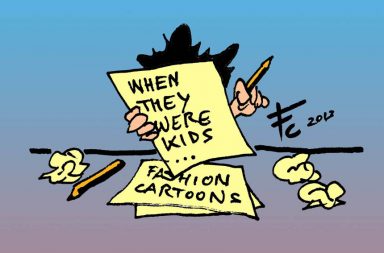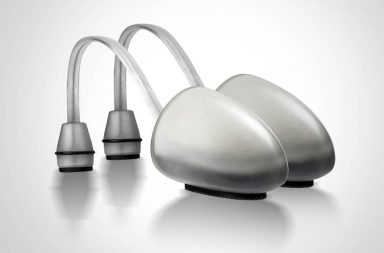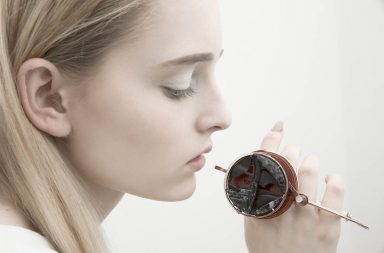Whenever we publish a post about conceptual or artistic collections, we are inevitably asked if the articles in question are really wearable or not. To clarify our editorial line, So Catchy! Where Fashion Begins is a supporter of fashion as a form of artistic expression, as are painting, sculpture, cinema, etc. Nothing interests us more than to see that before a collection hits the runway there is a period of intense research, exhaustive studies are performed in seemingly unrelated related fields such as architecture, engineering or applied technology and despite all of this, or because of it, the pieces in question in the form of a shoe, accessory of clothing become art, art that makes sense and has a creative force.

Now that we’ve made our point of view clear, we’d like to introduce you to Anuk Yosebashvili. The work of this young 29-year-old from the Black Sea republic of Georgia is so interesting that we would never be able to do it justice in a simple article. We only ask that you check out the photos before reading the text and that you reflect on the following questions: Is it wearable? And Is a painting wearable?
As for the artist herself, she has studied, amongst other things, the DNA of the fibers in her fabrics and she took fencing courses to better understand the basis of her collection. Notwithstanding, after various internships with brands such as Iris Van Herpen, she decided to learn how things are done from the other side, the production of mass fashion in China. Sound interesting? From So Catchy! Where Fashion Begins, we hope you enjoy the interview as much as we did.

SO CATCHY!: Your work is fascinating but, at the same time, complex. How would you define it?
ANUK YOSEBASHVILI: I spent many years exploring infinite aspects of design that interested me, and feel that I have now reached a stable personal design language that I am able to characterize as my own. This is compromised of artistic mathematical geometric and modular combinations.
SC!: Your pieces are very artistic, plastic and sophisticated…. What do you want to show us with them?
AY: I always like to show as much of myself and my thought process as possible in my work. I like to expose my mind to no limits or rules, and follow an idea and vision until it explodes. Eliminating barriers and making the impossible possible gives me a sense of amazing satisfaction that I crave. For instance, it was initially impossible to stand straight on 90 degree shoes until it became possible by creating an underwater experience in a photo shoot collaboration with ITR studio, the “into the deep” series.
SC!: What are you doing at the moment? We know you are in China… What do you do there?
AY: I came to China after an internship at IVH. Moving from Haute Couture to the heart of mass production and fast fashion was a big jump, two completely different worlds. Still, I knew that after 6 years of studies and internships full of creativity and crazy creations, the most “real world design” I could get would be in China. It is a great place to understand the exact process of the entire cycle from concept to production. The experience is teaching me how things work. This includes production, communication with different manufacturers and suppliers, and what I thought was the most difficult part, the necessity to simplify designs in order to take into account all the challenges and limitations posed by production, such as pricing, materials and quantities.
Today, I work as a footwear designer at Gagier Shoes LTD, and am responsible for kid’s Disney shoes. I feel that it is an amazing experience working with a brand such as Disney, and it is a great challenge and lesson to have to follow all the rules and guidelines that are set, something that I usually do not do or like to do. Still, the work I am doing today is a kind of escape into the world of fairy tales and colours, aspects that are not part of my own creations which are mainly black and sophisticated.
I still find it necessary to continuously be developing in my own design world, always creating and experimenting and finding new ways to represent the concepts that are in my mind. For this reason, I am also working on my new collection and planning to launch my own brand in the near future.

SC!: How was the experience of working for Iris Van Herpen? What did you do there?
AY: To be an intern is definitely not an easy job, especially with big names such as IVH. It was an interesting experience, and I think that it really helped me to better understand what fashion is, what design is, and if I really was ready to be part of this “crazy” competitive world named “Fashion”.
I first started my internship working mainly on clothing, but later focused on the development of the first ready-to-wear footwear collection for IVH. This was presented at the Paris Fashion Week, March 2013.
SC!: You once said: “I am interested in almost every traditional handcraft method and experiment with different materials and techniques, and also incorporate various innovative technologies in many of my works”. Do you think this is viable and compatible in the real commercial world?
AY: In my opinion, it doesn’t matter if the designs are commercial or artistic; both have to be born from deep research that has developed from experimenting with different materials and technologies. With no research trials, prototypes and experiments, even the commercial world cannot be viable and compatible.
SC!: Do you see yourself in the future creating artistic pieces or wearable ones?
AY: In the future, I aim to accumulate the knowledge I gained from my studies and experiences to design artistic and sophisticated products that are seen as artistic pieces but that can also be wearable. It is great to design futuristic art pieces, but it is more than great to take them one step further and simplify the designs enough to make them accessible and wearable. I hope my new collection can show and emphasize this vision.

SC!: We can see your collections have a lot of points of common: the strings (ballet and fencing inspiration), flexibility, geometric… We suppose that this has something to do with your passion for the sciences.
AY: Before entering the field of design, my dream was to study Genetic Engineering, a world of science and research that is amazingly interesting. For this reason, I had chosen biology and physics as my main courses in high school. But it was inevitable that my passion for design and creation was stronger when I found myself completing a Bachelor in textile design and specializing in knitwear. Regardless, I still found myself linked to my initial love of science by studying the “genome” of fibers and yarns, and turning this to the most important part and base of my studies. My interests in leather goods developed after completing my studies in textiles, and led me to continue my Masters in the field of footwear and accessory design. Today, i can definitely say that my strongest base in whatever I do is linked back to my study of textiles, which gives me the background and understanding of the complexity of different materials. For me, the dream to be a genetic counselor follows me in every piece that I design, and helps me to “engineer” my creations in every form, always almost from scratch.
SC!: Could you explain, with your own words, the collection: From 0º to 90º? We are really interested in the techniques you used (3D) to create them and the process from the idea to the piece.
The idea of the collection actually started from textile studies and research on conductive fabrics used in fencing. Studying the technology and mechanism used in fencing was the most important and interesting part of the collection for me and even led me to join a one-month beginners fencing class to deepen my research further.
Only after working on my first prototype for the project, and after the research on transformation of the body and the movements, did I establish a connection between fencing and ballet. I found that ballet originated from fencing in the 14th century, and that they were both from the same family. Although I unfortunately was not able to use the conductive fabrics in my final designs, I did use 3D printing technology for the toe cups.

In the second series of the project, I aimed to take the designs a step further and with Stratasys´ collaboration (manufacturer of 3D printers and 3D production systems) was able to use transparent material that combines in one printing 3 different materials. The Connex3 3D printing system that was used takes the Digital Materials technology to a much higher level. It allows for a wide range of different materials to be used simultaneously in forming art pieces.

The new series of ‘From 0º to 90º ‘ combines colored and transparent rigid materials, as well as transparent and black rubber-like materials. Together they formed Digital Material combinations that produced colored pieces of different transparencies and flexibilities in their different regions.
I think that, thanks to Stratasys, the collection was a great demonstration of technology. It showcased how the new multi-material 3D printing technology can be used as a fabrication tool for highly complex structures made of a combination of materials that was before never achievable in one process.

SC!: Tell us about your Second Skin Project.
AY: The research for this project began with a study on mazes and escape. It paralleled with looking at animals shedding their skins, such as with the snake. The pieces in one skin represent the idea of a one-piece object that multiplies, grows and becomes bigger. The Second skin project was part of the YKK special project for the ITS competition (Anuk was a finalist in this year’s edition), and so incorporated YKK products to strengthen the concept. For fastenings I used YKK snaps that allow the piece to deconstruct and reconstruct into different shapes.
SC!: From your point of view, what´s the future of footwear?
AY: The future of footwear and in design in general, is definitely advancing towards technology. It is developing at an extraordinary pace, and our job as designers will be to find the link to combine handcrafted techniques with the latest technologies. This must work in parallel to maintaining the very special soul and energy of any design and product, making sure that each has a human touch to it. I truly believe that no matter what advancement a designer may use, disregarding these links and combinations will risk any product to remain “machine made”, a piece with no soul or personality.

SC!: What do you really want to do? Do you see your dream as an impossible dream?
AY: In my opinion there is nothing impossible when one has enough knowledge, sense of commitment and creativity. With enough hard work, persistence and, most importantly, faith any dream can become a reality.
My dream is to design unique footwear and accessories for catwalks, in parallel to creating a personal brand.
SC!: You can´t stop wearing…
AY: Black. It became part of me and my personality, it feels natural to me.
SC!: Your favourite online fashion or art magazine?
AY: Art people gallery, Now fashion, Show Studio, A Magazine, The Art Newspaper.
SC!: And finally, a footwear designer that you admire…
AY: Kei Kagami.
Translation and layout by Michael Padilla
You can see more photos of Anuk Yosebashvili’s work here.
Photo credits:
Photo of Anuk by Yaron Shmerkin
Second Skin Project:
Photography: Hitomi Ko
Model: Santa Igaune
Makeup: Visen & Eda
0º to 90º collection
Photos by Tomer Burmad and Anuk Yosebashvili
0º to 90º new series
photos by D.Y. Reinshtein with Karina Bulatova
Digital Materials Researcher : Tal Ely -STRATASYS
Modeling: Yaron Shmerkin
Into the Deep series
Photos by: Javier Miqueleiz
Editing: Stas Kaminski
Styling: Shawna Pichen
Model: Nada Kurahashi
Nabadi Textiles series
Photos by Tomer Burmad




